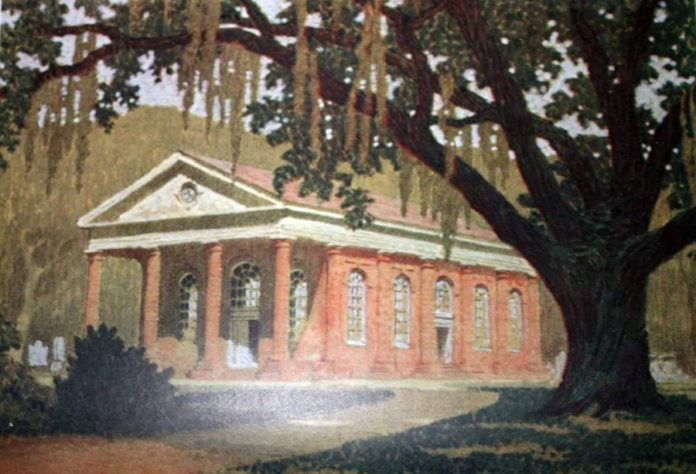
Have you ever wondered what the Sheldon Church looked before it was destroyed in the Civil War? An old painting shows it’s original look.
This recently discovered old restoration portrait would most likely be what Prince William’s Parish Church looked like prior to the 1860s. It was found in a book titled Prince William’s Parish and plantations, written by John Reynard Todd and published by Garrett & Massie in 1935. The image was brought to attention a few years back by Sonny Bishop of St. Helena Island.
This restoration drawing was done by John Wenrich and it was based on what parts of the Greek temple-styled building’s construction had been left behind. It was based on a study of existing walls and fragments of entablature that were later found on the grounds around the ruins.
Entablature is the superstructure of moldings and bands which lies horizontally above columns, resting on their capitals. Entablatures are major elements of classical Greek architecture, and the church was originally built using a Greek temple-style.
Prince William’s Parish History
The original walls and the four columns remain today, attesting to the solid construction and master craftsmanship which enabled it to withstand its 250 years of age. Completed by 1753, history claims the structure was burned by the British General Augustine Prevost in 1779 during the Revolutionary War. I
In 1826 it was rebuilt and legend again says it was later burnt by William Tecumseh Sherman who burned practically all the residences of neighboring plantations following the evacuation of Pocataligo by the Confederates, January 14, 1865.
In a letter from February of 1866, Beaufort’s Miton Leverett wrote that “Sheldon Church not burnt. Just torn up in the inside, but can be repaired.” The assumption is that the inside of the church was gutted to reuse materials in rebuilding homes around the area that were burned by Sherman’s army.
Whatever the accurate story actually is, the ruins today are surrounded by old majestic, Spanish moss filled Oaks and grave sites are scattered throughout the grounds.
Inside the ruins of the church lie the remains of Colonel William Bull, who assisted General Oglethorpe in establishing the physical layout of Savannah, Georgia. Bull surveyed the land in 1733 to form the basic grid pattern of the streets and squares, to which Savannah is now famous for.
The site was listed in the National Register of Historic Places on October 22nd, 1970.
It’s a good, safe bet to say that this is what Prince William’s Parish Church looked like in 1753 when its construction was completed.









